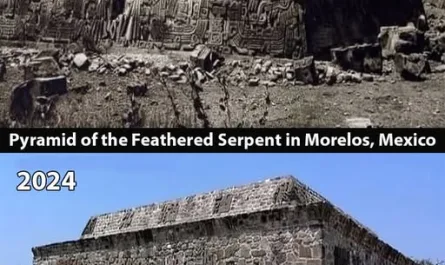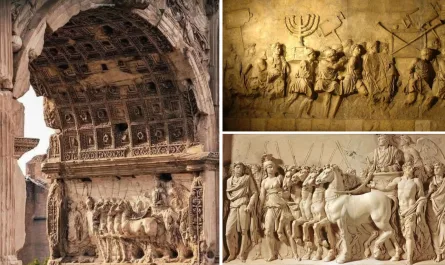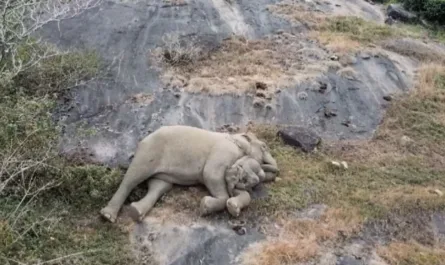On July 17, 1955, swimmers at the Desert Inn pool in Las Vegas witnessed a surreal spectacle as a mushroom cloud from a nuclear test, part of Operation Teapot, rose in the distance at the Nevada Test Site. This event highlighted the stark juxtaposition of leisure and annihilation in the city, where locals gathered to watch the atomic blast, viewing it either as a symbol of American optimism or a chilling reminder of the Cold War. Las Vegas was known as the only city where people could sunbathe beneath a nuclear sunrise.
The Event: On July 17, 1955, at 5:30 a.m., swimmers at a Las Vegas hotel paused to watch a mushroom cloud from a nuclear test.
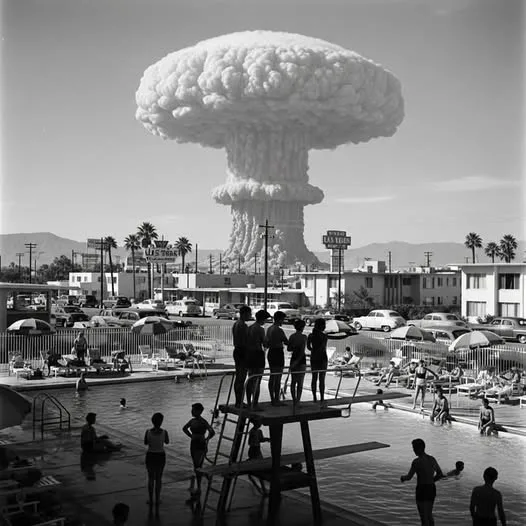
Location: The atomic blast occurred about 65 miles away at the Nevada Test Site.
Context: The test was part of Operation Teapot, a series of nuclear tests conducted at the Nevada Test Site in 1955.
Spectator Reaction: Locals, including sunbathers at the pool, gathered to watch the spectacle with lawn chairs and sunglasses.
Symbolism: The event came to symbolize American optimism and the reach of the Cold War for those who witnessed it.
Atomic Leisure: When Las Vegas Watched the Bomb for Fun
July 17, 1955. 5:30 a.m. Desert Inn Hotel, Las Vegas, Nevada.
The sky was still bruised with night when the first swimmers slipped into the turquoise pool. Chlorine shimmered under floodlights. A lifeguard yawned, coffee in hand. Children squealed on inflatable rafts shaped like swans. A couple in matching terrycloth robes sipped from ceramic mugs.
Then—a flash.
Not the sun. Not lightning.
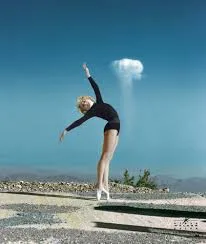
Sixty-five miles north, at the Nevada Test Site, the U.S. military had just detonated “Project Apple-2”, a 29-kiloton nuclear bomb suspended from a 500-foot tower. Part of Operation Teapot, the 14th in a series of 14 blasts that year alone.
The shockwave took 11 seconds to reach the Strip. Windows rattled. Water sloshed over pool edges. A baby cried.
And then—the cloud.
A perfect, terrible mushroom, rising 40,000 feet into the dawn. Pink and gold at the edges, black at its heart. It bloomed like a poisonous flower over the desert horizon.
But no one ran.
They watched.
“Dawn Over Doom Town”
That’s what the Las Vegas Sun called it the next day.
The city had been advertising atomic tourism for years. Billboards screamed: “See the A-Bomb! Only 65 Miles Away!” Hotels offered “Atomic Box Lunches” — bologna sandwiches and a view. The Chamber of Commerce handed out pamphlets:
“Witness the power of freedom—safely!”
And people came.
From L.A., from Phoenix, from small towns across the Southwest. They filled motels, packed station wagons, and rose before sunrise to claim their spot on rooftops, in parking lots, on the edge of the Desert Inn pool.
Children waved American flags. Photographers set up tripods. A beauty queen in a swimsuit posed with a Geiger counter—“Miss Atomic Bomb”, crowned just weeks earlier.
It was a spectacle. It was a party. It was insane.
The Science Wasn’t Invited
No one told the sunbathers about fallout.
The wind that morning blew south—directly toward Las Vegas. Radioactive particles—iodine-131, strontium-90, cesium-137—rained down invisibly. They settled on lounge chairs. They floated in the pool. They clung to skin, hair, and the rims of coffee cups.
The Atomic Energy Commission (AEC) assured everyone:
“No danger to the public.” “Radiation levels are negligible.”
They lied.
Decades later, downwinder lawsuits would reveal the truth:
- Children who played in the fallout developed thyroid cancer at 10 times the normal rate.
- Leukemia clusters appeared in St. George, Utah—100 miles away.
- Milk from local dairies was contaminated for weeks.
But in 1955? The show went on.
A City Built on Blast Waves
Las Vegas didn’t just tolerate the bombs—it embraced them.
Between 1951 and 1962, over 100 above-ground nuclear tests lit up the Nevada sky. The city timed them like clockwork:
- 4:30 a.m. detonation
- 5:00 a.m. mushroom cloud visible
- 6:00 a.m. casinos open for the atomic tourists
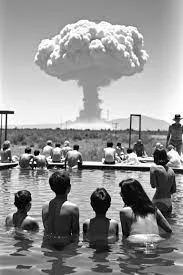
Hotels competed:
- The Flamingo offered “Atomic Cocktails” (vodka, champagne, and a dash of fallout—kidding, but not by much).
- The Sands had a “Bomb Viewing Lounge” with panoramic windows.
- The Golden Nugget gave out “I Saw the Mushroom Cloud!” certificates.
Even the Miss Atomic Bomb pageant had a twist: contestants wore cotton swimsuits painted with mushroom clouds. The winner? Lee Merlin, photographed with a cotton puff exploding from her chest—“the original mushroom cloud bikini.”
The Children Who Watched
Some of the clearest memories belong to the kids.
“We’d wake up at 4 a.m.,” recalls one former Las Vegan. “Mom packed Kool-Aid and bologna sandwiches. Dad drove us to the edge of town. We sat on the hood of the car and waited. When the flash came, we counted—one-Mississippi, two-Mississippi—until the boom. Then the cloud. It was… beautiful. Like God turned on a light.”
They didn’t know the light was poison.
The End of the Party
The atomic sunrise ended in 1963.
The Partial Test Ban Treaty, signed by the U.S., USSR, and UK, banned above-ground nuclear tests. The bombs went underground. The clouds vanished.
Las Vegas pivoted. No more mushroom clouds? Fine. They’d sell sin instead.
But the legacy lingered.
The Reckoning
In the 1980s and 1990s, the downwinders fought back.
- Irene Williams, a St. George teacher, testified before Congress:
“We were the guinea pigs. They told us it was safe. My students died.”
- RECA (Radiation Exposure Compensation Act) was passed in 1990, offering $50,000 to victims. Over 35,000 claims filed. Many denied.
The Desert Inn pool? It’s gone. The hotel was demolished in 2001 to make way for the Wynn Resort.
But the photos remain.
The Image That Says Everything
One photograph from that morning survives in archives: A little girl in a polka-dot swimsuit, standing on a diving board. Behind her, the mushroom cloud towers—monumental, serene, apocalyptic. She’s smiling. She has no idea.
The caption in the Las Vegas Review-Journal read: “Dawn of a New Age.”
It was. But not the one they thought.
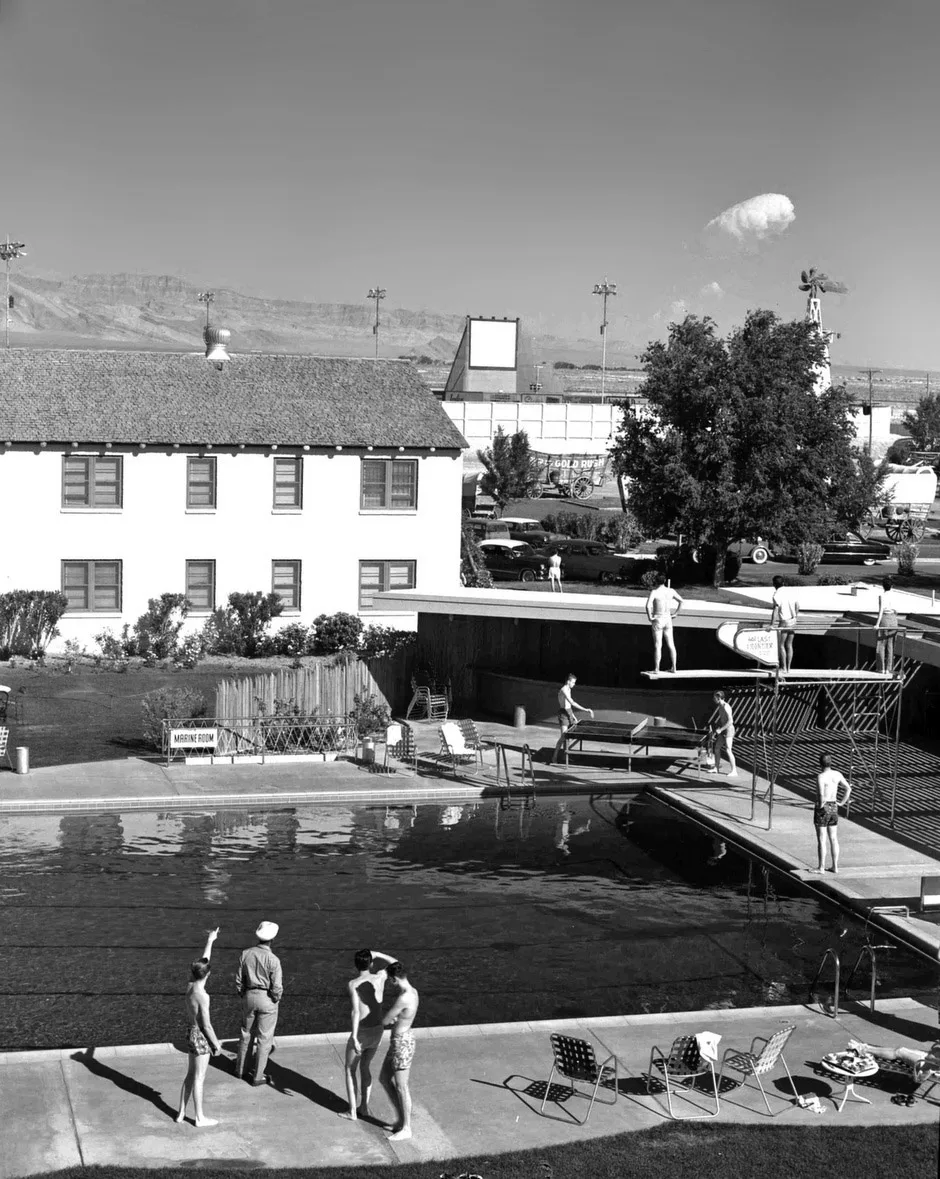
Atomic Leisure Today
You can still visit the National Atomic Testing Museum in Las Vegas. Walk through a replica bunker. Feel the simulated blast. Watch grainy footage of cheering crowds.
The gift shop sells “I Survived the Atomic Bomb” T-shirts. Irony included.
Outside, the Strip glitters—neon, fountains, fake volcanoes. No one looks north anymore.
But on quiet mornings, when the wind shifts just right, some old-timers swear they can still taste metal in the air.
The Moral
Las Vegas sold apocalypse as entertainment. America bought it.
We told ourselves:
“It’s far away.” “It’s safe.” “It’s progress.”
We were wrong.
The bombs are gone. The fallout isn’t.
And somewhere, in a photo album yellowed with time, a child in a swimsuit still smiles beneath a cloud that should never have been beautiful.
Atomic leisure wasn’t just a moment. It was a warning.
We ignored it.
Let’s not ignore the next one.
